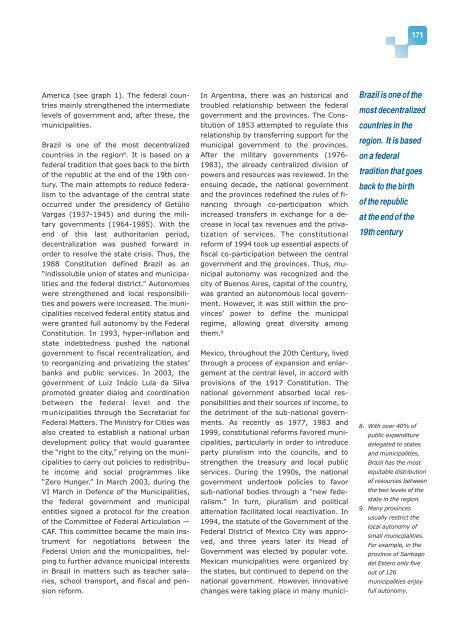GOLD Report I - UCLG
GOLD Report I - UCLG
GOLD Report I - UCLG
You also want an ePaper? Increase the reach of your titles
YUMPU automatically turns print PDFs into web optimized ePapers that Google loves.
171America (see graph 1). The federal countriesmainly strengthened the intermediatelevels of government and, after these, themunicipalities.Brazil is one of the most decentralizedcountries in the region 8 . It is based on afederal tradition that goes back to the birthof the republic at the end of the 19th century.The main attempts to reduce federalismto the advantage of the central stateoccurred under the presidency of GetúlioVargas (1937-1945) and during the militarygovernments (1964-1985). With theend of this last authoritarian period,decentralization was pushed forward inorder to resolve the state crisis. Thus, the1988 Constitution defined Brazil as an“indissoluble union of states and municipalitiesand the federal district.” Autonomieswere strengthened and local responsibilitiesand powers were increased. The municipalitiesreceived federal entity status andwere granted full autonomy by the FederalConstitution. In 1993, hyper-inflation andstate indebtedness pushed the nationalgovernment to fiscal recentralization, andto reorganizing and privatizing the states’banks and public services. In 2003, thegovernment of Luiz Inácio Lula da Silvapromoted greater dialog and coordinationbetween the federal level and themunicipalities through the Secretariat forFederal Matters. The Ministry for Cities wasalso created to establish a national urbandevelopment policy that would guaranteethe “right to the city,” relying on the municipalitiesto carry out policies to redistributeincome and social programmes like“Zero Hunger.” In March 2003, during theVI March in Defence of the Municipalities,the federal government and municipalentities signed a protocol for the creationof the Committee of Federal Articulation —CAF. This committee became the main instrumentfor negotiations between theFederal Union and the municipalities, helpingto further advance municipal interestsin Brazil in matters such as teacher salaries,school transport, and fiscal and pensionreform.In Argentina, there was an historical andtroubled relationship between the federalgovernment and the provinces. The Constitutionof 1853 attempted to regulate thisrelationship by transferring support for themunicipal government to the provinces.After the military governments (1976-1983), the already centralized division ofpowers and resources was reviewed. In theensuing decade, the national governmentand the provinces redefined the rules of financingthrough co-participation whichincreased transfers in exchange for a decreasein local tax revenues and the privatizationof services. The constitutionalreform of 1994 took up essential aspects offiscal co-participation between the centralgovernment and the provinces. Thus, municipalautonomy was recognized and thecity of Buenos Aires, capital of the country,was granted an autonomous local government.However, it was still within the provinces’power to define the municipalregime, allowing great diversity amongthem. 9Mexico, throughout the 20th Century, livedthrough a process of expansion and enlargementat the central level, in accord withprovisions of the 1917 Constitution. Thenational government absorbed local responsibilitiesand their sources of income, tothe detriment of the sub-national governments.As recently as 1977, 1983 and1999, constitutional reforms favored municipalities,particularly in order to introduceparty pluralism into the councils, and tostrengthen the treasury and local publicservices. During the 1990s, the nationalgovernment undertook policies to favorsub-national bodies through a “new federalism.”In turn, pluralism and politicalalternation facilitated local reactivation. In1994, the statute of the Government of theFederal District of Mexico City was approved,and three years later its Head ofGovernment was elected by popular vote.Mexican municipalities were organized bythe states, but continued to depend on thenational government. However, innovativechanges were taking place in many munici-Brazil is one of themost decentralizedcountries in theregion. It is basedon a federaltradition that goesback to the birthof the republicat the end of the19th century8. With over 40% ofpublic expendituredelegated to statesand municipalities,Brazil has the mostequitable distributionof resources betweenthe two levels of thestate in the region.9. Many provincesusually restrict thelocal autonomy ofsmall municipalities.For example, in theprovince of Santiagodel Estero only fiveout of 126municipalities enjoyfull autonomy.
















